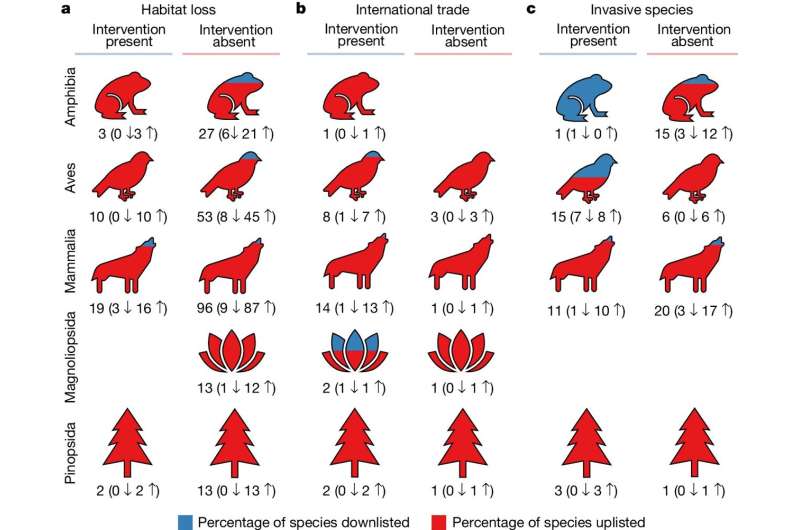This article has been reviewed according to Science X's editorial process and policies. Editors have highlighted the following attributes while ensuring the content's credibility:
fact-checked
peer-reviewed publication
trusted source
proofread
New study finds many of the world's most threatened species lack evidence of sufficient conservation efforts

A new study has revealed alarming gaps in the implementation of conservation interventions for thousands of the world's most threatened species.
The research, published in the journal Nature, shows that most terrestrial plant and animal species at risk of extinction from threats like habitat loss, over-exploitation for trade, and invasive species are not receiving the appropriate types of conservation efforts needed to protect them.
The study findings suggest that there is a serious mismatch between the biodiversity crisis we are facing, and the actions being taken to combat it.
The researchers have found insufficient or even no conservation attention for over half of threatened species that they analyzed for this study.
The international team of researchers, led by Dr. Rebecca Senior of Durham University, examined data from the International Union for Conservation of Nature (IUCN) Red List of Threatened Species, Map of Life and other sources.
They assessed the extent to which 5,963 threatened terrestrial species are benefiting from habitat protection in reserves, regulations on threatened wildlife trade, invasive species control/eradication programs, and other key conservation measures.
Disturbingly, they found that only 9% of species threatened by habitat loss have minimally sufficient areas of their habitat represented within protected areas.
Just 24% of species threatened by invasive alien species like rats, cats and fungal diseases are receiving documented control of those problem species.
They also point out that birds receive far more conservation attention than other groups like amphibians and plants.
Commenting on the research findings, lead author Dr. Senior of Durham University said, "Conservation can and does work, but only if we try. Our findings are so concerning because they highlight that we're not really trying for most of the species at the greatest risk of extinction. If that carries on, there's little to no hope that these threatened species will recover on their own.
"That means countries around the world would fail to meet their commitments to stem the tide of biodiversity loss, and that has huge ramifications for both people and the ecosystems on which we depend."
Study co-author Prof David Wilcove of Princeton University said, "It is essential that governments and environmental organizations make a concerted effort to address these deficiencies in conservation attention before it's too late.
"We're talking about a sinking ark where there aren't enough life boats on board and the crew isn't even sure where those lifeboats are located."
The researchers did find some positive signs that conservation can work when applied effectively.
Species that were downlisted to lower threat categories on the IUCN Red List between 2006–2020 were more likely to have documented conservation interventions in place compared to those that deteriorated in status. However, most up listings to higher extinction risk categories occurred despite some efforts being made, suggesting those interventions were insufficient.
Conservation can and does prevent extinctions, but the study results indicate we are headed towards a catastrophic loss of biodiversity if we don't implement more and better conservation measures soon.
Many threatened species appear to be merely neglected with little to no evidence of direct efforts focused on recovering their populations.
The researchers note some limitations in documenting all conservation efforts but argue the number of seriously neglected threatened species indicates a major deficit in global interventions that must be urgently prioritized and funded, especially in biodiversity-rich developing nations.
They call on all parties to the Kunming-Montreal Global Biodiversity Framework to greatly accelerate strategic and well-funded conservation programs to meet agreed upon goals for limiting extinction rates.
More information: Rebecca Senior, Global shortfalls in documented actions to conserve biodiversity, Nature (2024). DOI: 10.1038/s41586-024-07498-7. www.nature.com/articles/s41586-024-07498-7
Journal information: Nature
Provided by Durham University




















